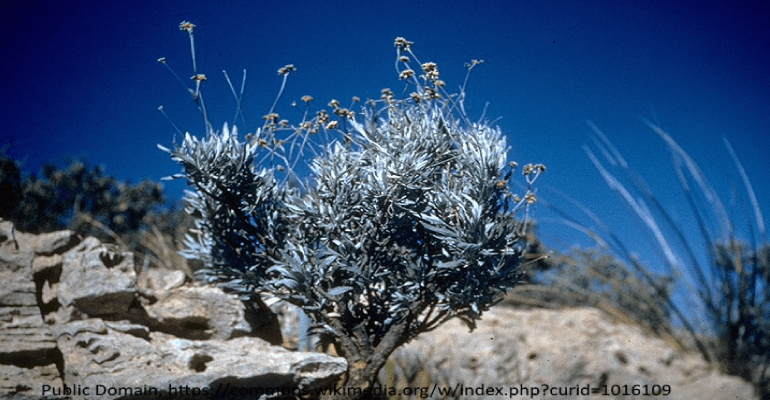
Guayule ((Parthenium argentatum) is a small woody, flowering shrub native to the southwestern United States and northern Mexico. Latex can be produced from the bark of this plant. Unlike rubber produced from tropical plants, the latex in guayule is hypoallergenic, i.e., it does not contain certain proteins found in tropical plants that cause latex allergies. (See photos here)
According to Purdue University:
Guayule has been known as a source of rubber since the pre-Columbian times when Indians of Mexico used it to form balls for their games. There were several efforts beginning in 1900 to commercially produce rubber from guayule. A major effort occurred during World War II.
Guayule is adapted to hot desert environments, and sites with well-drained calcareous soils and relatively low concentrations of nutrients. Sandy-loam soil is most suitable since root diseases, which are exacerbated by standing water, are one of the few problems encountered in guayule cultivation. (Source)
The University of Arizona, in cooperation with the U.S. Department of Agriculture have been studying guayule for about 15 years. That research included growing the plant at several sites in Arizona.
According to the UofA:
Guayule is a renewable, low-water use industrial crop. Products from guayule are made using non-polluting, water-based processes that require no toxic chemicals. Guayule-based products are also biodegradable, high-performing substitutes for many synthetic, petroleum-based products that are often expensive to dispose of and hazardous to the environment.
The Yulex Corporation has the exclusive license to a patented process to produce latex and products from Guayule. One patent covers a novel method for extracting and manufacturing Guayule natural rubber latex. The second patent covers rubber products made from such novel methods.
Extracting latex from Guayule involves homogenizing the entire hedged Guayule plant. Rubber is found primarily in the bark and must be released in the processing. Branches are ground into a kind of “Guayule milkshake” by gently breaking open the cells in the plant, releasing intact rubber particles and creating an aqueous suspension which is placed in a centrifuge for separation. Since the Guayule rubber particles are lighter than the aqueous solution, they are separated from the suspension. The rubber portion of the mixture is culled off the top (much the same way that cream is skimmed off milk) and purified into latex. (Source)
According to the U.S. Department of Agriculture:
Guayule may also prove to be an economical, environmentally friendly source of yet another prized commodity: energy. That energy can be made from the ground-up stems and branches, called “bagasse,” that are left after their latex has been removed. Guayule bagasse would provide 8,000 to 9,000 Btu per pound, about the same as charcoal. (Source)
Guayule is being considered as a new commercial crop in Arizona (along with agave and hemp) because it uses less water than traditional crops.
Note to readers:
Index with links to all my ADI articles: http://wp.me/P3SUNp-1pi
My (newly updated) comprehensive 30-page essay on climate change: http://wp.me/P3SUNp-1bq
A shorter ADI version is at https://arizonadailyindependent.com/2013/08/01/climate-change-in-perspective/
If you like murder mysteries, type the name Lonni Lees (my wife) into Amazon or Barnes & Noble sites to see her novels, a book of short stories, and reviews. For synopses and more reviews of her books see: https://wryheat.wordpress.com/lonnis-murder-mysteries/
